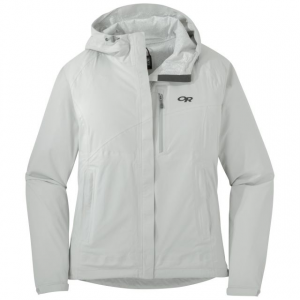The Outdoor Research Panorama Point is a lightweight rain jacket that can be used year-round for hiking, backpacking, and all of your recreational pursuits. That's actually harder to come by than you think. While there are lots of lightweight rain jackets that you can use for three season wear, few have the additional venting and temperature regulation features required for serious winter hiking and backpacking. This jacket's outer shell also has some stretch to it which makes it very comfortable to wear and surprisingly quiet. If you can only afford to buy one jacket for year-round use, you'll be hard pressed to find one that's this fully featured and affordable.
Specs at a Glance
- Gender: Men's Fit (11 oz size L), Women's Fit (9.6 oz size M)
- Type: 2.5L Waterproof/Breathable
- External Fabric: 100% nylon 40D mechanical stretch ripstop
- Membrane: Ventia (Outdoor Research Proprietary Laminate)
While the Panorama Point is made with OR's proprietary waterproof/breathable laminate, I wouldn't get too excited about that aspect of this jacket. Most Gore-tex knock-offs have pretty lackluster performance (and OR doesn't publish specs for theirs.) Companies use them to reduce the cost of jackets and because a breathable layer is considered a check-box feature with consumers, regardless of its effectiveness.
What I like about Outdoor Research rain jackets and winter hard shells, which I'm been using for over a decade, is that they usually put pit-zips or even longer torso-zips on their rain jackets, even when they have a breathable membrane. Venting is the most effective way to dump the excess body heat that leads to perspiration, as well as the built-up water vapor that's generated when you sweat. I've never had much faith in the laboratory-tested breathability claims made by any manufacturer and their applicability for field use. All of the rain jackets and winter shells I use when I'm not testing gear have pit zips and torso-zips for that reason. Your mileage in 100% humidity may vary.
Jacket Features
The Panorama Point Jacket is loaded with all of the features that are you want on a jacket that can span four-season use.
- a fully adjustable hood including neck toggles and a volume reducer
- hood wire brim
- pit zips
- velcro wrist cuffs
- chest pocket and two side pockets
- hem cinch
- two-way zipper
Fully Adjustable Hood
The Panorama Point's hood has neck toggles and a rear volume reducer so you can cinch the front to prevent heat loss, block wind, and reduce the volume to fit your head. I consider these must-have features on any rain jacket that you intend to use for hiking and backpacking. Your head generates a lot of heat when you hike and it's important to retain it when you're cold or vent it when you're two warm. You can't do that if you can't cinch it down tight and prevent the wind from whistling through, or if the hood is sized for a helmet, which is a common problem on winter shells, and too big for your head.

Wire brim
Hoods with wire brims are great because you can reshape them easily. They also help prevent rain from dripping onto your face or glasses. If you have a jacket without a brim or one with just a fabric brim, you'll probably need to carry a ball cap to keep rain off your face, which is just added weight to carry.
Pit Zips
The Panorama Point has 11″ long pit zips under the arms with two-way zippers. They're easy to reach and adjust while wearing the jacket and do a good job at dumping excess heat without letting in additional moisture when it's raining.
Velcro wrist cuffs
The arms have velcro wrist cuffs that you can cinch closed to prevent heat loss. You have a lot of blood flowing through the wrist that's close to the surface of your skin, so preventing cold air from reaching it is an important way to keep your hands warm. They also prevent cold rain from dripping down your arm and wetting your mid-layer.

Pockets
The jacket has three zippered pockets, all lined with mesh. The chest pocket is large enough to hold a smartphone (or GPS). In fact, it has an interior sleeve to hold a phone, so it won't fall out when you open the pocket (awesome feature!). There are also two huge side pockets and the left pocket has a key fob w/ clip sewn into the seam. Unfortunately, the side pockets are not hip belt compatible and will be covered if you're wearing a backpack.
Hem cinch
The jacket has an elastic hem cinch which is good for trapping heat in cold and windy weather, and to help prevent spindrift from blowing up under your jacket in powder.

Two-way Zipper
A two-way zipper is another highly desirable feature, particularly on a winter shell, because it give you the ability to rapidly vent excess heat and even wear your jacket like a cape, for maximum ventilation.
External Fabric, DWR, and Waterproofing
The OR Panorama Point is made with a 40 denier ripstop that has some stretch built into in, making the jacket very quiet and comfortable when you need to scramble. The external fabric has a very soft hand but still has a very good DWR coating on it to shed rain. However, if you wear it with a backpack, you should expect the DWR coating to rub off rather quickly around the shoulders and waist due to shoulder strap and hip belt abrasion.
You have two options, you can restore the DWR coating periodically (every 30-60 uses) with a product like Nikwax TX Direct Spray-on. It's good to wash jackets like these periodically, like every 3-6 months, which is a convenient time to reapply the DWR. You can even wash it in, in the washing machine, with Nikwax TX-Direct Wash-in, which is even more effective and more convenient.
What's DWR? It stands for durable water-repellent and is a chemical coating they cover the outside of waterproof/breathable rain jackets with to make rain bead up when it hits the jacket and roll off. This prevents the outer fabric from getting soaked through, which in turn, blocks the breathable membrane from releasing water vapor.
If the outer fabric of the jacket becomes soaked and you'll probably experience more internal condensation build-up inside the jacket than you would normally. But the breathable membrane in the Panorama Point is waterproof, so rain water won't seep into the jacket even if if the external fabric is saturated in normal circumstances. If you get a rain jacket that's permanently waterproof and made with silnylon or polyurethane, you still have to deal with internal condensation buildup, so there's ultimately no way around the issue.
Recommendation
The Outdoor Research Panorama Point Jacket is a comfortable and well featured rain jacket that can serve double duty as a winter shell. It is full featured with all of the capabilities that you'd expect in a technical shell but at a fraction of the price because it uses OR's proprietary breathable layer and not more expensive Gore-tex. If you believe in manufacturer's breathability claims, go buy a more expensive jacket. But if you've never been able to detect any noticeable difference, or you beat the crap out of your rain jackets by wearing shoulder straps and hip belts (ie backpacks), the Panorama Point will provide as much value as a more expensive jacket. Outdoor Research makes the best hiking rain gear in my experience and the Panorama Point is another good one.
See Also:
- How to Buy a Hard Shell for Winter Hiking
- Outdoor Research Foray Jacket Review
- Outdoor Research Helium II Rain Jacket Review
Compare 6 Prices
-
 Moosejaw
Moosejaw $179.00$106.99View -

 REI.com
REI.com $179.00$124.73View -

 REI.com
REI.com $179.00$124.73View -

 CampSaver.com $131.62View
CampSaver.com $131.62View -

 Amazon US
Amazon US $179.00$178.95View -

 CampSaver.com $178.95View
CampSaver.com $178.95View -
 Moosejaw $178.95View
Moosejaw $178.95View -
 Moosejaw $178.95View
Moosejaw $178.95View
Disclosure: OR provided the author with a jacket for this review.
Help support this site by making your next gear purchase through one of the links above. Click a link, buy what you need, and the seller will contribute a portion of the purchase price to support SectionHiker's unsponsored gear reviews, articles, and hiking guides.The post Outdoor Research Panorama Point Rain Jacket Review appeared first on Section Hikers Backpacking Blog.
from Section Hikers Backpacking Blog https://ift.tt/2IcpqpZ




No comments:
Post a Comment